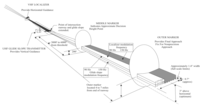Instrument landing system

Have you ever heard of a machine that helps airplanes land safely even when there is bad weather outside? That machine is called an instrument landing system (ILS).
Now let me explain how it works, imagine you are playing a game where you have to follow a path, but you can’t see where you’re going because the path is covered with things like fog, rain, or snow. It’s tough to figure out where you are going, right?
Well, that is exactly what happens when an airplane tries to land during bad weather. The ILS is like a special helper that guides the airplane to safely land on the runway. It's like a roadmap for pilots that tells them where to go and what to do when it's tough to see outside.
The ILS has two main parts: the localizer and the glide slope. The localizer is like a line that tells the pilot whether they are to the left or right of the runway – it tells them where to turn. The glide slope is like a slope that tells the pilot how quickly they should descend – it tells them when to land.
These two together give the pilot all the info they need to land safely, even when they can’t see the runway, simply by following the arrows on their instrument panel.
In summary, the Instrument Landing System helps pilots see through bad weather and guides them to land safely on the runway.
Now let me explain how it works, imagine you are playing a game where you have to follow a path, but you can’t see where you’re going because the path is covered with things like fog, rain, or snow. It’s tough to figure out where you are going, right?
Well, that is exactly what happens when an airplane tries to land during bad weather. The ILS is like a special helper that guides the airplane to safely land on the runway. It's like a roadmap for pilots that tells them where to go and what to do when it's tough to see outside.
The ILS has two main parts: the localizer and the glide slope. The localizer is like a line that tells the pilot whether they are to the left or right of the runway – it tells them where to turn. The glide slope is like a slope that tells the pilot how quickly they should descend – it tells them when to land.
These two together give the pilot all the info they need to land safely, even when they can’t see the runway, simply by following the arrows on their instrument panel.
In summary, the Instrument Landing System helps pilots see through bad weather and guides them to land safely on the runway.
Related topics others have asked about:
